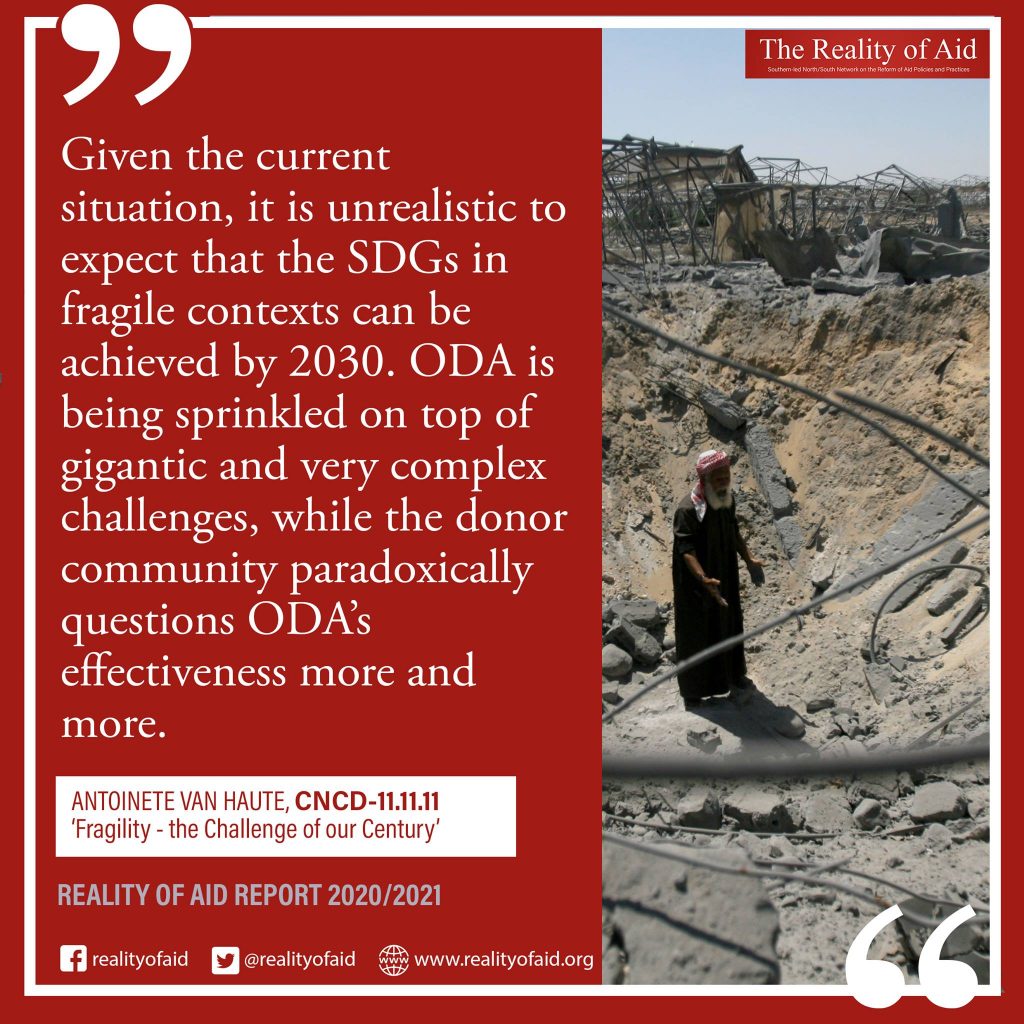
CNCD-11.11.11’s Antoinette Van Haute focuses on the issue of fragility and how it adds to the world being off-track from achieving SDGs in conflict-affected and fragile countries.
Antoinette Van Haute, CNCD 11.11.11, Belgium
This is an excerpt from a chapter in the RoA Report 2020/2021. Download the full chapter here.
Fragility is one of the most significant challenges of our century. The principles of the fragility approach are relevant not only to the present state of development cooperation but also to the ways in which it can improve moving forward.
Fragility is generally defined by the Organization for Economic Co-operation and Development (OECD) as the “combination of exposure to risks and the insufficient adaptive capacity of the state, system and/or communities to manage, absorb or mitigate those risks.” “States of Fragility”, the 2018 OECD biannual report, counts 58 fragile states in the world, all of which are situated in contexts that make the UN Sustainable Development Goals (SDGs) extremely challenging to meet.
If the SDGs are to be achieved, the development community must act fast to address the specific challenges of development cooperation in fragile contexts. While there is no “one-size-fits-all” solution, let us recall five principles particularly crucial to development cooperation in fragile contexts. These five principles are:
- Work on the root causes of fragility. An analysis of the root causes behind the different challenges that a fragile state faces allows the development community to allocate aid more efficiently and sustainably. It must promote conflict prevention and increase the financing of structural development cooperation, aimed at building long-term resilience rather than averting short-term crises.
- Strengthening the rule of law must be the fundamental objective of development programming. Good governance and a strong relationship between the state and its citizens play pivotal roles in ensuring that a state’s laws and policies, as well as the observance of the rule of law, align with the fundamental respect for human rights and freedom—this includes promoting the principle of national ownership and the protection and strengthening of civil society actors.
- Flexible cooperation committed to the long term. Long-term cooperation in fragile contexts must be flexible and able to adapt to changing contexts; this allows the donor country to remain engaged if relations with the recipient country government become difficult.
- Starting from the local context. Learning and understanding the local context and priorities of a fragile state allows donors to respect the principle that development cooperation must be aligned with local development priorities, not with the interests of the donor countries themselves.
- Internal and external coherence. Internally, the principle of policy coherence for development (PCD) must guide the full range of external policies; it requires at a minimum that all of a donor’s external policies do not thwart the objectives of development cooperation. Externally, it is crucial that all donors coordinate with each other at a global level to harmonize and avoid the current asymmetry of aid allocation in fragile states.
So why are we still talking about this? It seems no matter how many concepts we come up with, no matter how many times we repeat the same principles in the fragility approach, the truth is: the international donor community is tackling the world’s biggest challenge with totally insufficient means. The reality of what is being done, versus what is still needed, is daunting.
According to the World Bank, 100 million additional people will fall into extreme poverty in 2020 because of the coronavirus. The public debt of developing countries has gone from 100% to 193% of their GDP from 2008 to 2019. Added to these worsening conditions is the well-known financing gap for the SDGs. The global pandemic greatly diminishes the possibilities for future progress.
ODA is being sprinkled on top of gigantic and very complex challenges, while the donor community paradoxically questions ODA’s effectiveness more and more. While the effectiveness of development assistance is undeniably important, it is imperative that there be sufficient and predictable financial resources to support long-term development strategies.
Belgian cooperation must equip itself with instruments adapted to the reality of fragile states. A growth plan will have to be defined to increase Belgium’s ODA, so that it meets its commitment to allocate 0.7% of the GNI to ODA as soon as possible. The additional funding this would provide should be allocated to the aforementioned priority areas of the fragility approach.
